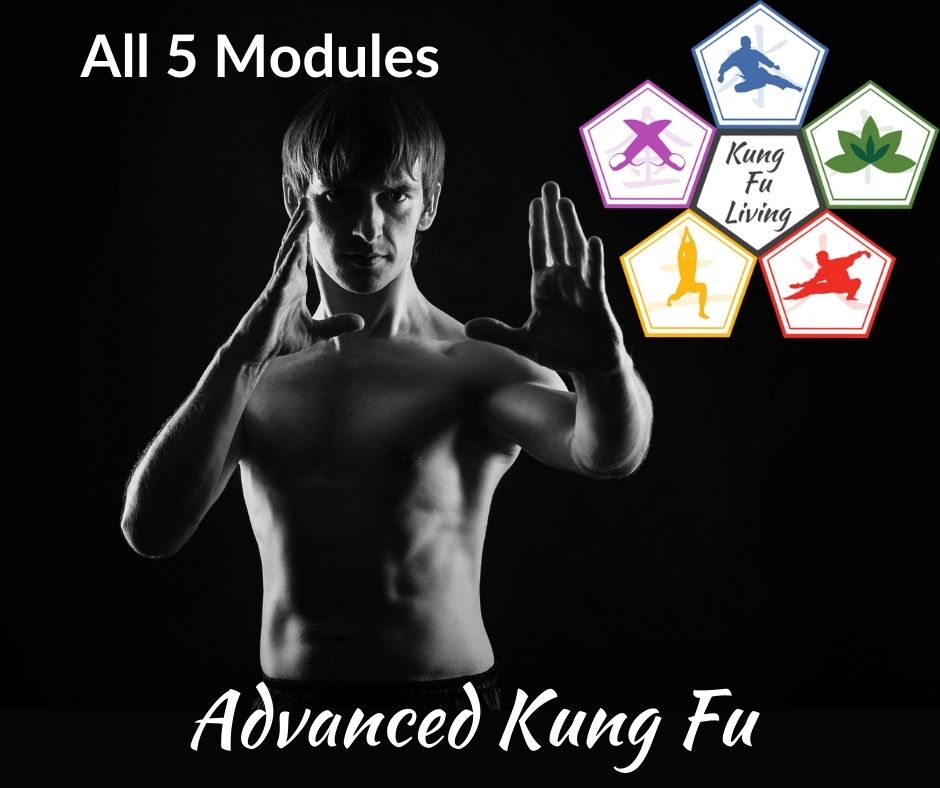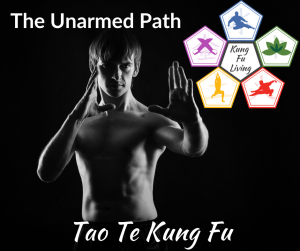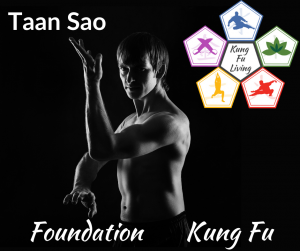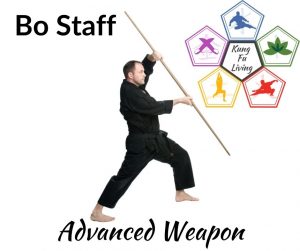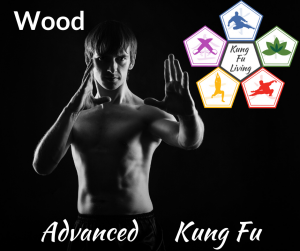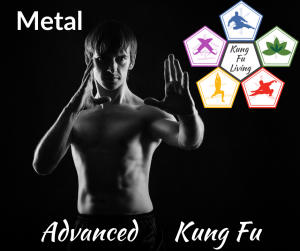The Kung Fu Living training programs are the best structured and accessible way to learn Martial Arts online. This curriculum has been developed by professional teachers and martial artists with over 60 years of experience & training in the dojo, in tournaments and in the security industry. This online training enables beginners and existing martial artists to easily and quickly learn Kung Fu and reach their full potential. Learning the Tao Te Kung Fu martial art style with Kung Fu Living via our step by step daily guide is the most complete and easily accessible means of personal development for everyone.
This course contains all 5 of the Advanced Tao Te Kung Fu modules.
You will be guided every day with a selection of lessons and Kung Fu exercises for at home that are designed to enable you to make steady and continuous progress covering the advanced modules you have chosen. All courses are studied through the Kung Fu Living App which is provided with any course.
The Advanced Level
In each of the five advanced modules, you will learn a form that incorporates each of the Chinese elements, representing different styles/attitudes that are appropriate for different martial artists in different contexts. In addition to learning double blocks, more strikes and kicks you will learn more sophisticated combinations that are designed to give you real-life tactical advantages.
Water
Water has mass, weight and although it is ultimately very flexible, fluid you might say, it can still hit you very hard. Water will move around an object in its way, but once it is moving, circling around a bolder for example, that circular current can knock you over. While you are learning and practicing the water form, visualize your self in water. I don’t mean as if you are trying to move against the resistance of still water. I mean imagine that the water is swirling around and is moving you; your whole body. Try to feel yourself softly flowing, circling and moving as the water pushes you around. As you visualize this, you will find that you perform the Water form with much more grace and fluidity. When your whole body is moving as one fluid motion your technique will become better and better. You will be able to speed up your movements and because your whole body will be generating power, your techniques will be unstoppable. Imagine, if you are 70kg, that a strong plastic bag holding 70kg of water were to be swung around until it was moving fast. If that bag of water hit you, you would be thrown across a room. Hold that idea as you move your whole body to deliver a strike. Water is not always soft.
What You’ll Learn
- The Taan/Bong Sao double block that allows you to defend more of your body in a yielding manner
- The turning side kick combination utilized when you want to use your momentum to your advantage in unique situations
- The powerful hook punch
- Use of body mass and circling movements to yield in a way that redirects body weight into an attack
- Unique circling steps and footwork to guide and trap your opponent to your advantage
- Use of the straight stance but incorporating forward and rear stance weight transference
- Overall strategy for understanding when to move in aggressively and when to keep defensively on the back foot for maximum advantage
Fire
Fire has no mass of course. It can’t wait around for an opening, it has to burn while the fuel is there. Fire is passionate; it attacks with absolute optimism. Some of the moves in the Fire Form are high risk, meaning that to execute the attack leaves you vulnerable and open, all be it for just a moment. Fire flickers, and while it is very aggressive, it doesn’t throw your weight in like stone does. Even the initial block is immediately incorporated into a strike. There is some degree of attacking so fast and furiously that your opponent doesn’t really have a chance to counter.
What You’ll Learn
- An aggressive blocking style used to come at your opponent while defending to put you in a good position to land your next strike
- The front elbow strike, a powerful close range attack
- The double front kick combo used to keep attacks up when you want to keep a powerful opponent at range
- Combos focusing on attacks from different heights and angles to make them unpredictable to your opponent
- Fast, linear and aggressive footwork to keep you light on your feet and ready to land and attack at a moments notice
- Use of the straight stance but incorporating forward and rear stance weight transference
- Overall strategy for understanding when to move in aggressively and when to keep defensively on the back foot for maximum advantage
Metal
Metal is the element which, above all, focuses on skill, precision and accuracy. While other elements help you to push certain strategies and physical attributes to the extreme, strength and aggression for example, metal takes a balance with these things and favours a the few well placed, well-timed moves, that outclass your opponent in skill rather than speed or strength. It means that with enough training and honing of yourself, as with the crafting and practice of a good tool or weapon, you will be able to almost effortlessly achieve your task.
What You’ll Learn
- A system of precise striking techniques that focused on targeting to win over pure speed or power
- The vertical backfist, a fast and difficult to predict attack that opens an opponent up for further attacks
- The downward knife hand, a powerful yet easy to target strike with many vulnerable targeting options
- A knife hand figure 8 combos used to string together fast and accurate attacks without losing momentum
- An angled knee strike used to attack the torse of your opponent even if they are guarding their front well
- Use of the straight stance but incorporating forward and rear stance weight transference
- Overall strategy for understanding when to move in aggressively and when to keep defensively on the back foot for maximum advantage
Wood
Watch a young tree bending in the wind and then snapping back, or an old willow catching the wind on one side as it gusts along a river and see the branches swirl and slap. Perhaps you’ve walked through a young forest where the branches are in your way and your friend, in front of you has bent a branch away as they have pushed past, only for the branch, when released to whip back and hit you. If so you already have a sense of the tension that can be stored in wood. As you learn and practice this Wood form, picture yourself like a tree. The wind blows you one way or makes you twist, holding that torque in you core muscles and rooted to the ground, you are able to unwind, accelerating into a strike releasing all that power. Wood has a very particular way of storing tension and can be devastating when that tension is directed at something. Remember, the earliest artillery devices, Roman ballista or medieval trebuches and the like, might have been hurling metal bolts or rocks, but is was wood that provided the lever to throw them.
What You’ll Learn
- How to use flexibility and yielding to then strike back at your opponent with their own power as well as your own
- The horizontal backfist, a powerful swinging attack with good reach and can be combined with many follow up attacks
- How to combine stronger strikes together using momentum
- A turning side kick combo’d with the front and round kicks for an unrelenting attack sequence
- How to yield to an opponent using good stance strategy and use their own force against them
- Use of the straight stance but incorporating forward and rear stance weight transference
- Overall strategy for understanding when to move in aggressively and when to keep defensively on the back foot for maximum advantage
Stone
Don’t think of a huge heavy rock just sitting there. Oop, too late, that’s exactly what you are doing now. Now think of rocks in motion. Picture a landslide on a rocky mountain side. Thousands of individual rocks and stones, that from a distance appear to flow down the slope. Now that’s the image to visualize while you are practicing the Stone form. It is unrelentingly aggressive; gets in close and smashes its way through. There is often an assumption that you have to be big and heavy to do this form well, but that just means you have never hit your thumb with a hammer. What did the hammer weigh? 1 kilo? What do you weigh? 40? 50? Yep, that’s quite small for a person I guess. Now picture a 40kg hammer and imagine what damage that would do if it was swung and hit someone in the middle of their chest. Even if swung slowly, that sort of weight hammer would smash anyone off their feet, breaking their ribs in the process. Got the picture yet? Stone is belligerent, it doesn’t go around, it smashes through.
What You’ll Learn
- A powerful and aggressive double block designed, not only to defend you but crash through your opponent’s guard
- The reverse elbow strike, a strong close range attack used when your opponent is outside your attacking arm
- The upward elbow, a strong close range attack that is difficult to block
- The downward elbow, a risky and difficult to set up but fight winning attack
- The front knee strike, a devastating leg attack used at close range that can finish a fight quickly if landed
- How to combine punches together with maximum force and power
- Overall strategy for understanding when to move in aggressively and when to keep defensively on the back foot for maximum advantage

